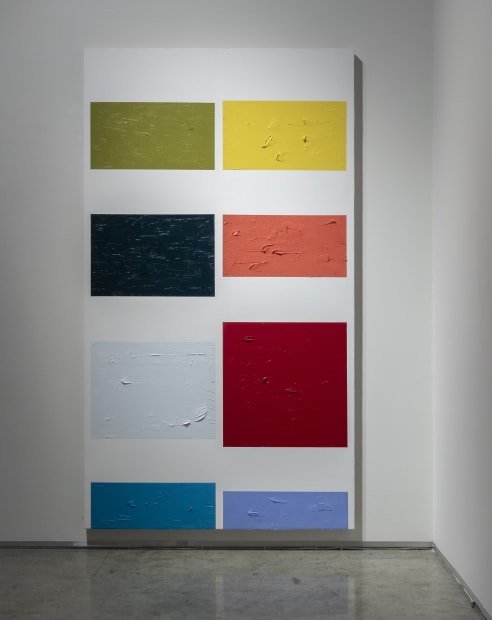-
-
-
This is roughly the running time of the looping audio narration in Divecha’s Gallery 354 (2019), the immersive installation that sets the central premise to Vikram Divecha’s solo exhibition Towards Opacity.
-
-
Gallery 354, 2019
Looped voice recording 10 minutes 28 seconds, spent light bulbs from the Metropolitan Museum of Art, discarded cardboard box, darkroom safelight, 4”x5” direct positive paper, developing trays with photography chemistry solutions and safelight holder, water, folding table, studio monitor, media player, partition wall fittings, wall paint, blackout fabric, carpet, printed cards, wooden shelf
Edition of 2 (+1 AP)
-
-
On one of Divecha’s trips to the MET, he had intended to photograph some of the Melanesian ancestral objects on view, but all that was captured was blank images.
The darkroom Gallery 354 (2019) we enter is a memorial to failure, where one finds the traces of a charged encounter - a resistance to representation by an exhibited object, already opaque to the museum goer. If there is any identity to be found in the darkroom, then it is in the recorded voice, which a 19th century German poet, once described as “the true photograph of the soul”. Divecha’s recorded narration speaks in order to tell us of a voice that is other than his own, reverberating in an uncharted region – his unconscious starts to speak. In other words, what we hear is that “je est un autre” (I is another) of Rimbaud. This is the same affirmation of self-difference that Martinique-born philosopher Edouard Glissant invokes when he affirms opacity as a common denominator in the errant and unfinished work of Relation. In contravention of the museum’s ordained mode of spectatorship and comprehension, Divecha encounters these museum objects as an opaque echo of what was always, already within himself. He explains “These objects speak to me of another space, another period, possibly located within myself”.
-
-
The relationship between wood and sunlight, 2018 (Detail)
Scrap pieces from Columbia University woodshop, white marker, laminated plywood, metal frame, Ikea floor lamp
Variable dimensions -
-
In a continuing gesture of embracing multiple voices in his work, Divecha collected scraps from the wood shop at Columbia University to piece together The relationship between wood and sunlight (2018). This work was conceived as a model - or a three-dimensional sketch from memory - of the objects in Gallery 354. The fact that it is assembled from the discarded remainders of other artists’ labor already suggests a degree of authorial relinquishment. By seeking out discarded pieces of wood that often only vaguely resemble his already imperfect mental images of the objects in the museum, Divecha echoes the initial opacity of those displayed objects. At the same time, the installation’s single light source evokes the direct sunlight that the Melanesian objects at the MET are protected from by massive shades installed on the museum’s Southwest facing windows. Extracted from its immediate museological context, the maquette of remainders can be thought of as an absurd commentary on the museum’s painstaking efforts for preservation.
“THESE OFFCUTS SUGGESTED MELANESIAN OBJECTS ONLY IN THEIR VERTICALITY, BUT MIGHT EQUALLY HAVE BEEN READ AS THE SIMPLIFIED PLACEHOLDER IMAGES WE ENCOUNTER ONLINE BEFORE AN IMAGE COMPLETELY LOADS."
- RAHEL AIMA ON VIKRAM DIVECHA – ARTFORUM INTERNATIONAL
-

-

-
-

Google Images search entry: Childhood; Device: iPhone SE (A1723); Display aspect ratio 16:9, 2019
-

Google Images search entry: Displaces; Device: iPhone SE (A1723); Display aspect ratio 16:9, 2019
-

Google Images search entry: Precisely; Device: iPhone SE (A1723); Display aspect ratio 16:9, 2019
-

Google Images search entry: Production; Device: iPhone SE (A1723); Display aspect ratio 16:9, 2019
-

Google Images search entry: Splitting; Device: iPhone SE (A1723); Display aspect ratio 16:9, 2019
-

Google Images search entry: Argued; Device: iPhone SE (A1723); Display aspect ratio 16:9 2019, 2019
-

Google Images search entry: Production; Device: iPhone SE (A1723); Display aspect ratio 16:9, 2019
-

Google Images search entry: Need; Device: iPhone SE (A1723); Display aspect ratio 16:9, 2019
-

Google Images search entry: Should; Device: iPhone SE (A1723); Display aspect ratio 16:9, 2019
-
-

-

Click here to flip through our online catalogue.
-
Vikram Divecha | Towards Opacity | Press Release
Read the exhibition reviews in Harper's Bazaar Arabia | Artforum International | The National
















